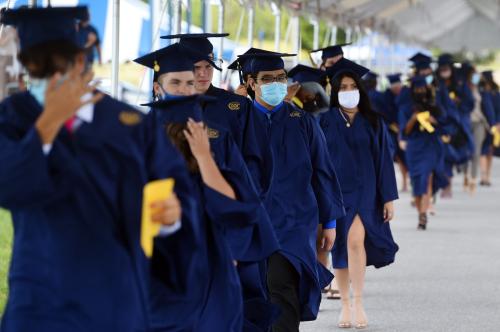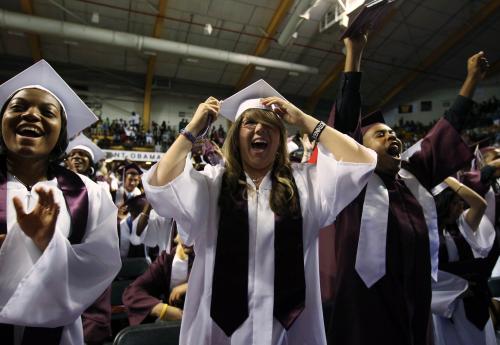Americans are realizing that the current financial aid system doesn’t go far enough in making college affordable. Student loan debt just surpassed $1.5 trillion, and the disparities in access by race and income continue to grow. To combat these negative trends, a new wave of reform calls for college to be free—and programs across the nation have already started to make this idea a reality.
On Sept. 20, the Brown Center on Education Policy at Brookings hosted an event to present the results of new, original research on a free college program, followed by a discussion of the broader policy implications of college promise models. Brown Center Director Michael Hansen moderated the conversation, which featured: Brookings Nonresident Senior Fellow Doug Harris; New Jersey Secretary of Higher Education Zakiya Smith Ellis; Manhattan Institute Senior Fellow Beth Akers; College Promise Campaign Executive Director Martha Kanter; and Robert Kelchen, a professor at Seton Hall University.
The Degree Project: Results and policy lessons
Doug Harris has spent nearly a decade designing and studying the ins and outs of The Degree Project, a Milwaukee-based college promise program that shares many similarities with others across the country. His recently released evaluation, “The promise of free college (and its potential pitfalls),” not only provides valuable insight on the impact of The Degree Project but also on college promise programs overall and how they might be designed going forward.
Results from @douglasnharris et al’s #freecollege paper. In their experiment of a program similar to promise programs, they find both positive effects, such as elevated student motivation, and not-so-positive effects, such as no impact on initial college entry. pic.twitter.com/2iHZzPsr65
— Brookings Brown Center (@BrookingsEd) September 20, 2018
Started in 2011, The Degree Project was a college promise program in which eligibility for students was determined through a randomized control trial in Milwaukee Public Schools. Of the 36 schools, half were in the test group, which offered a first-year cohort up to $12,000 (enough to complete a two-year degree) upon completing high school with a minimum 2.5 GPA and 90-percent attendance rate.
The results showed mixed effects of the free college program. For students in the test program, the availability of money did increase motivation and steps toward college, and researchers saw a slight increase in long-term enrollment and graduation from 2-year colleges. Yet, students didn’t exhibit higher GPAs, attendance, or graduation rates, nor higher initial college entry rates. Only 21 percent of the test group actually met the standards for the money. Harris’s takeaway from this? Avoid performance requirements in college promise programs (doing so provides the benefit to students who are already likely to attend college), and use these programs as a way to catalyze change in schools and communities (widespread communication and a permanent program will be more likely to effect the cultural change college promises seek to achieve).
How should the future of free college play out?
While the panelists held different views on the policy details of free college, they agreed on a central point: As free college programs play out at the state and local level, attention to design and implementation will be critical. As Martha Kanter put it, “Promise programs have a lot to learn.”
One idea, echoed by the panelists and the research findings, was to simplify the delivery of financial aid. Offering students the clear expectation of free college in high school may be a more efficient strategy for boosting enrollment than leaving students to navigate the complexities of the financial aid process after graduation. Doug Harris noted this as a possible explanation as to why The Degree Project wasn’t successful in boosting immediate enrollment rate—the promised aid came late, leaving students without a clear means of paying for college.
.@SecSmithEllis: Anytime you can provide more information to students on the benefits of financial aid, it’s a good thing. #Freecollege makes it clear what the benefit is up front, and has the ability to cut through the noise in a way that FAFSA simplification can’t. pic.twitter.com/PNwAcVA2mK
— Brookings Brown Center (@BrookingsEd) September 20, 2018
Promise program architects should also consider costs aside from tuition. As Robert Kelchen pointed out, free tuition only goes so far if students cannot cover their living expenses out of pocket. He explained that many colleges are wary to let students borrow money for these costs. While the concern of students defaulting on debt for living costs is valid, it is important to consider what alternatives students have.
Panelists also weighed in on who free college programs should target—a pertinent point when funds are limited. Zakiya Smith Ellis discussed her own experience implementing New Jersey’s free college pilot program, The Community College Innovation Challenge. There, the program targets students whose families make less than $45,000 a year. There’s also the question of giving funds for two-year versus-four year colleges. In Harris’s mind, that’s a decision that depends on local need; in some localities, two-year degrees make more sense than others.
The question of college choice came up as well: Are students going to feel pressured to attend two-year and community colleges, and at what cost? Smith Ellis acknowledged the risks of funneling students away from starting a four-year degree, but supported free community college for being “open access” and readily available to students, who can always apply credits to a four-year degree after.
The panel wrapped up with a final question from Mike Hansen: What does the future of free college look like? As research and discussion on free college proposals ramps up, Beth Akers expressed her excitement for programs at the state level that will be shaped by strong evidence. The panelists agreed that a free college movement is here and growing, and that it will be a conversation to follow through the midterms and beyond.
You can listen to audio and watch the full event here.
Alex Walinskas contributed to this post.





Commentary
As free college programs move forward, experts agree that design matters
October 2, 2018